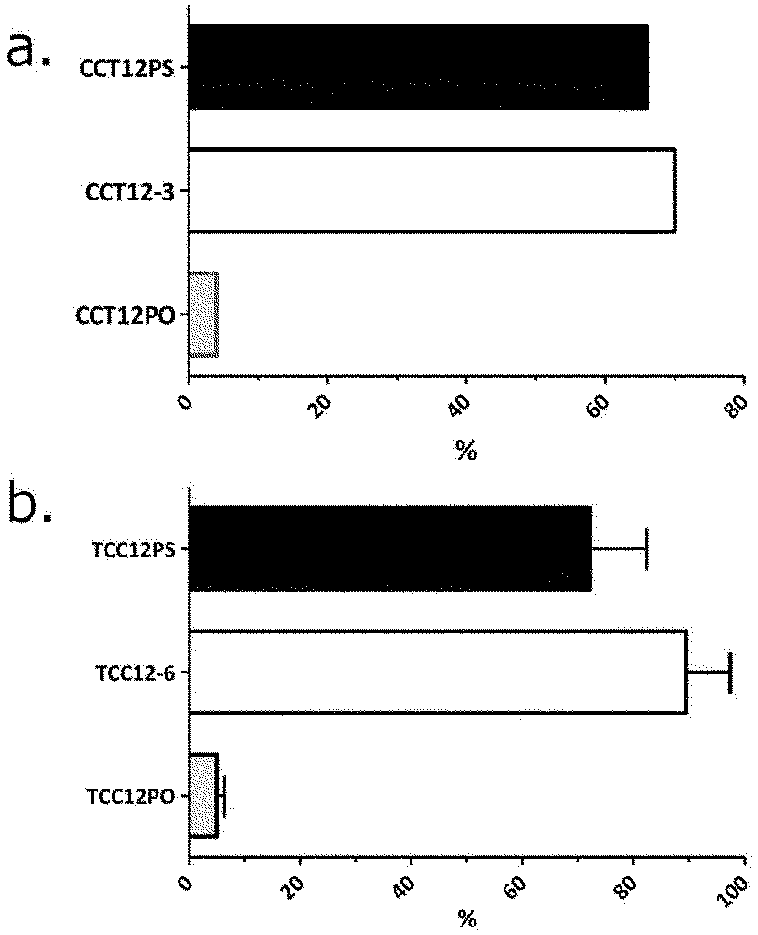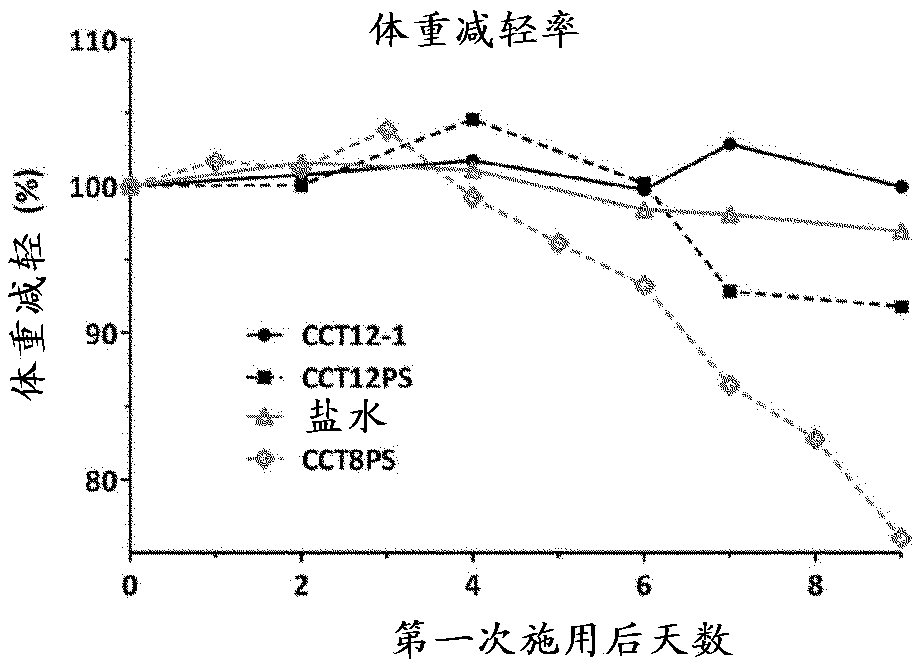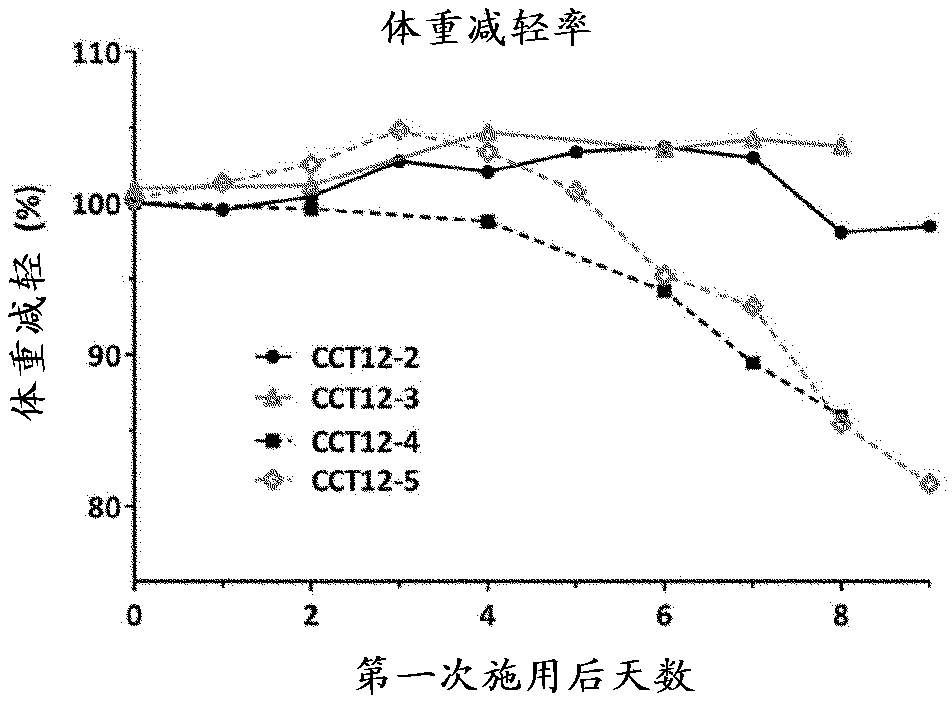Tlr inhibitory oligonucleotides and their use
A technology of oligonucleotides and nucleotides, applied in the field of TLR inhibitory oligonucleotides and their applications, can solve problems such as inability to perform nucleotide sequences
- Summary
- Abstract
- Description
- Claims
- Application Information
AI Technical Summary
Problems solved by technology
Method used
Image
Examples
Embodiment 1
[0212]Stability of partially phosphorothioated oligonucleotides compared to oligonucleotides with normal phosphodiester bonds or phosphorothioated oligonucleotides
[0213]
[0214] Oligonucleotides (10 ng / uL) were incubated with 20% (v / v) human serum (Cosmo Bio, Cat. 12181201) in distilled water (DW) at 37°C. The oligonucleotide-containing solution was collected after 1 day incubation and checked for the concentration of remaining undegraded oligonucleotide. The concentration of oligonucleotides in solution was determined by hybridization assays using complementary oligonucleotides of (CCT)12 or (TCC)12 as probes that detect only Oligonucleotides for full-length oligonucleotides.
[0215]
[0216] figure 1 The proportion of intact oligonucleotides remaining after 1 day incubation in serum-containing medium is shown; this proportion is expressed in % compared to the concentration of oligonucleotides at the beginning of the study. Such as figure 1 As shown in a, CCT12PO...
Embodiment 2
[0218] In Vivo Toxicity Examination of Oligonucleotides
[0219]
[0220] Oligonucleotides were dissolved in saline at 2 mg / ml and injected subcutaneously into mice (BALB / c) at 100 uL / 10 g body weight once daily for 7 consecutive days to give 20 mg / kg (mpk). Check the body weight of the mice to see if the oligonucleotide shows any effect on body weight. exist Figures 2a to 2c In the graph of , the X-axis represents the number of days from the first dose (ie, day 0 is the first day of dosing; day 6 is the last day of dosing). The mean body weight (3 animals per group) is shown on the Y-axis with the scale set to 100% from the beginning of the study.
[0221] The day after the last dose (day 7), blood collected from the mice was biochemically analyzed for effects on markers indicative of liver damage such as alanine aminotransferase (ALT). Figure 2d with 2e The blood ALT concentration is shown on the Y axis. ALT is often measured clinically as part of the diagnostic eva...
Embodiment 3
[0229] Inhibits NF-kB transcriptional activity
[0230]
[0231] The CAL-1 / NF-kB-GFP cell line was established for monitoring the activity of the NF-kB transcription factor in a cell-based assay (WO2014 / 082254). The vector encoding the GFP reporter gene driven by the NF-kB consensus transcriptional response element was transfected into the human plasmacytoid DC cell line by electroporation; CAL-1 (human pDC cell line, Maeda et al., Int J Hematol., 2005 , 81, 148-54, JP5011520). Transfected cells were further selected with antibiotics. Then, CAL-1 / NF-kB-GFP cells (1×10 5 / well) were seeded in 96-well flat-bottomed plates (Costar) and cultured with TLR agonists with or without oligonucleotides of the present invention. Cells at 37 °C in 5% CO 2 Incubate for 4 hours (TLR7 / 8) or 6 hours (TLR9) in a humidified incubator. The ratio of GFP-positive cells detected by flow cytometry (FACSCalibur, BD Bioscience Co., Ltd) shows NF-kB as data from cells without inhibitors (Medium) ...
PUM
 Login to View More
Login to View More Abstract
Description
Claims
Application Information
 Login to View More
Login to View More - R&D
- Intellectual Property
- Life Sciences
- Materials
- Tech Scout
- Unparalleled Data Quality
- Higher Quality Content
- 60% Fewer Hallucinations
Browse by: Latest US Patents, China's latest patents, Technical Efficacy Thesaurus, Application Domain, Technology Topic, Popular Technical Reports.
© 2025 PatSnap. All rights reserved.Legal|Privacy policy|Modern Slavery Act Transparency Statement|Sitemap|About US| Contact US: help@patsnap.com



